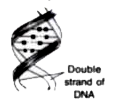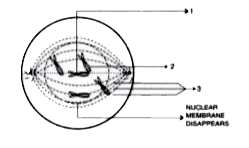Suggest two points of difference between plasmid and chromosomal DNA.
To answer the question regarding the differences between plasmid and chromosomal DNA, we can outline the following points:
1. Shape and Structure:
- Plasmid DNA: Plasmids are typically circular in shape and are considered extra-chromosomal DNA, meaning they exist independently of chromosomal DNA within the cell.
- Chromosomal DNA: In contrast, chromosomal DNA is generally linear in structure and forms the main genetic material of an organism, organized into chromosomes.
2. Association with Proteins:
- Plasmid DNA: Plasmids are not associated with histone proteins. This means that they do not have the same level of structural organization as chromosomal DNA.
- Chromosomal DNA: Chromosomal DNA is associated with histone proteins, which help in packaging the DNA into a compact structure, allowing it to fit within the cell nucleus and play a crucial role in gene regulation.
Summary of Differences:
- Plasmid DNA: Circular, extra-chromosomal, not associated with histone proteins.
- Chromosomal DNA: Linear, part of the main genome, associated with histone proteins.
- Plasmid DNA: Plasmids are typically circular in shape and are considered extra-chromosomal DNA, meaning they exist independently of chromosomal DNA within the cell.
- Chromosomal DNA: In contrast, chromosomal DNA is generally linear in structure and forms the main genetic material of an organism, organized into chromosomes.
- Plasmid DNA: Plasmids are not associated with histone proteins. This means that they do not have the same level of structural organization as chromosomal DNA.
- Chromosomal DNA: Chromosomal DNA is associated with histone proteins, which help in packaging the DNA into a compact structure, allowing it to fit within the cell nucleus and play a crucial role in gene regulation.
- Plasmid DNA: Circular, extra-chromosomal, not associated with histone proteins.
- Chromosomal DNA: Linear, part of the main genome, associated with histone proteins.
Topper's Solved these Questions
- BIOTECHNOLOGY-PRINCIPLES AND PROCESSESBOOK - AAKASH INSTITUTE ENGLISHCHAPTER - BIOTECHNOLOGY-PRINCIPLES AND PROCESSESEXERCISE - Try Yourself
17 Videos
- BIOTECHNOLOGY-PRINCIPLES AND PROCESSESBOOK - AAKASH INSTITUTE ENGLISHCHAPTER - BIOTECHNOLOGY-PRINCIPLES AND PROCESSESEXERCISE - EXERCISE
40 Videos
- BIOTECHNOLOGY AND ITS APPLICATIONSBOOK - AAKASH INSTITUTE ENGLISHCHAPTER - BIOTECHNOLOGY AND ITS APPLICATIONSEXERCISE - ASSIGNMENT (SECTION - D) (ASSERTION - REASON TYPE QUESTIONS)
10 Videos
- BODY FLUIDS AND CIRCULATIONBOOK - AAKASH INSTITUTE ENGLISHCHAPTER - BODY FLUIDS AND CIRCULATIONEXERCISE - Assignment Section - D Assertion - Reason Type Questions
9 Videos
Similar Questions
Which of the following is not a basis of difference between plasmid and chromosomal DNA ?
a.Presence of histones
b. Nature of histones
c. Nature of nucleotide
d. Linear form of genetic material
View SolutionGive two points of difference between thermoplastic and thermosetting polymers.
View Solution
Knowledge Check
The difference between RNA and DNA is because of :
Asugar and baseBsugar and phosphateCphosphate and baseDsugar only
Given below is a diagram of a double helical structure of DNA.

Mention two points of difference between Mitosis and Meiosis.
View SolutionGiven two point of difference between cathode rays and anode rays
View SolutionGiven below is a diagram representing a stage during mitotic cell division in an animal cell:

Mention two points of difference between 'mitosis' and 'meiosis' with regard to :
The number of daughter cells formed.
The chromosome number in the daughter cells.
View SolutionWrite two points of difference between interference and diffraction pattern of light.
View SolutionCan you think of any difference between DNAs and Dnase.
View SolutionDiscuss differences between blunt ends and sticky ends of DNA.
View SolutionState any two structural and one functional difference between DNA and rRNA.
View Solution
